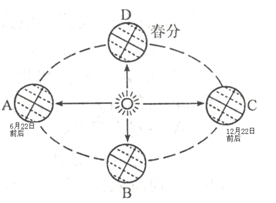读图,完成填空。(8分)

(1)当地球公转至A处时,太阳直射_____ _,地球上出现极夜的范围是____ __ _。(66.5° N --90° N、66.5° S --90° S)
(2)地球公转至B处时,太阳直射______ _,时间是______ _前后.
(3)当地球在公转轨道上由C向D转动的过程中,泰州市由_______季节向_______季节过渡,昼夜长短变化是白天越来越_______。(长、短)
(4)在图中标出地球公转的方向。
(1)北回归线 66.5° S --90° S.
(2)南回归线 9月22日或23日.
(3)冬 春 长.
(4)略.
题目分析:
(1)当地球公转至A处时,为北半球的夏至日,太阳直射北回归线,北极圈之内(66.5° S --90° S)出现极夜现象.
(2)地球公转至B处时,为北半球的秋分日,太阳直射赤道,时间为9月22日或23日.
(3)当地球在公转轨道上由C向D转动的过程中,泰州市也就是由冬至(冬季)向春分(春季)过渡,白天越来越长,黑夜越来越短.
(4)地球公转的方向是自西向东,为逆时针.
